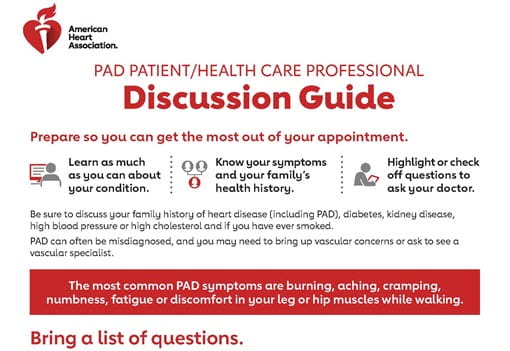Symptoms of PAD
What are the symptoms of PAD?
The most common symptom of lower-extremity peripheral artery disease is painful muscle cramping in the hips, thighs or calves when walking, climbing stairs or exercising.
The pain of PAD often goes away when you stop exercising, although this may take a few minutes. Working muscles need more blood flow. Resting muscles can get by with less.
If blood flow is blocked due to plaque buildup, the muscles won’t get enough blood during exercise to meet the needs. The cramping pain (called intermittent claudication) is the muscles’ way of warning the body that it isn’t receiving enough blood during exercise to meet the increased demand.
Many people with PAD have no symptoms or mistake their symptoms for something else.
Download our PAD Symptom Checker (PDF) | Spanish (PDF)
Other symptoms of PAD include:
- Leg pain that doesn't go away when you stop exercising
- Foot or toe wounds that won't heal or heal very slowly
- Gangrene, or dead tissue
- A marked decrease in the temperature of your lower leg or foot compared to the other leg or the rest of your body
- Poor nail growth on the toes or hair growth on the legs
- Erectile dysfunction, especially in men with diabetes

View our interactive library to learn more about PAD and leg pain.
Understanding leg pain
Many people dismiss leg pain as a normal sign of aging. You may think it's arthritis, sciatica or just "stiffness" from getting older. For an accurate diagnosis, consider the source of your pain. PAD leg pain occurs in the muscles, not the joints.
Those with diabetes might confuse PAD pain with a neuropathy, a common diabetic symptom that's a burning or painful discomfort of the feet or thighs. If you're having any kind of recurring pain, talk to your health care professional and describe the pain as accurately as you can. If you have any of the risk factors for PAD, you should ask your health care professional about PAD even if you aren't having symptoms.

Support That Lifts You Up
Our online community of patients, survivors and caregivers is here to keep you going no matter the obstacles. We’ve been there, and we won’t let you go it alone.

